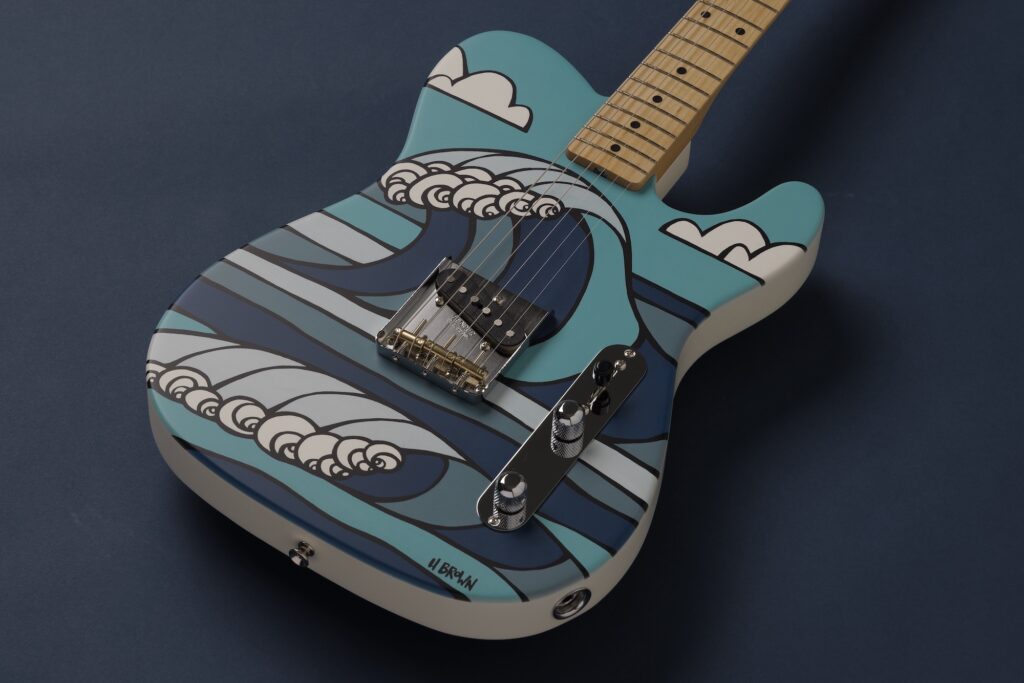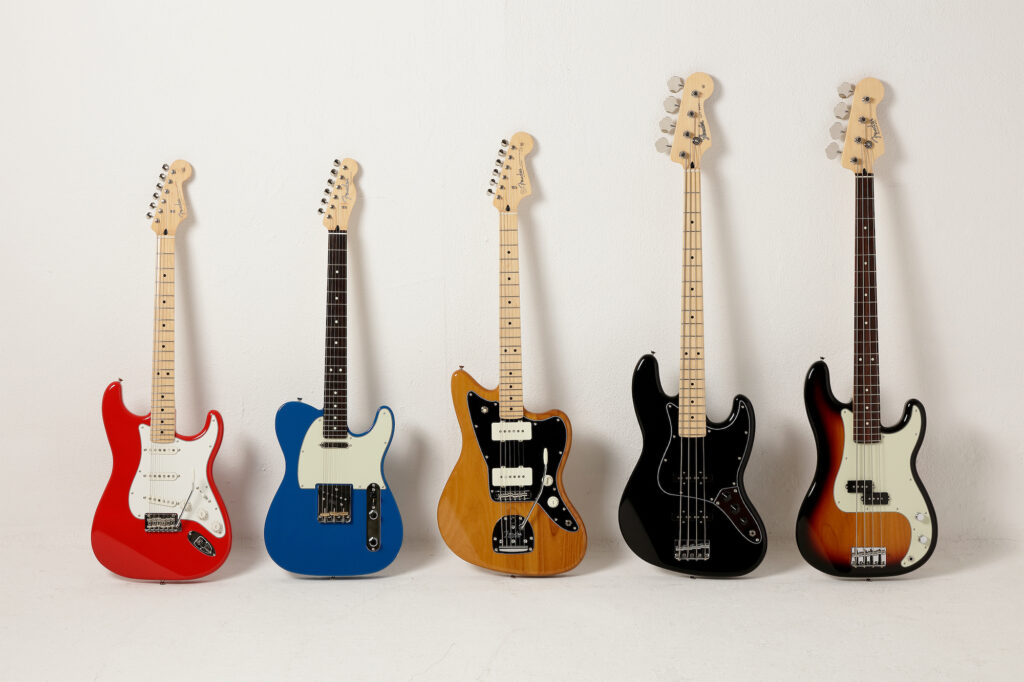Japanese guitar culture is, was, and always will be a beast of its own — often dwarfing anywhere else in the world, including America.
A look around any of Japan’s major guitar stores (Ishibashi Music, for example) provides a borderline overwhelming experience compared to your typical stroll around their American equivalents. While certain stores elsewhere may specialize in rare and imported guitars, Japan’s guitar market is centered around a multitude of brands, styles, features and options that simply aren’t available overseas.
These days, those Japanese exclusives are seen as collectibles for many guitarists and are worth well above their retail value to the right buyer. While some Japanese brands ship worldwide, many manufacturers only sell within the Asia-Pacific region (or sometimes exclusively in Japan) and have to be imported by a third party to purchase elsewhere.
But Japanese guitars weren’t always viewed this way.
For an instrument that hasn’t changed much since the mid-20th century, the meaning of “Made in Japan” in the guitar world has seen a major evolution in public perception over the decades. While they’re now often considered a premium item on marketplace platforms such as eBay and Reverb — and that’s before considering government-related import fees (which generally total at least 10% of the item’s value in America, and can be even more elsewhere in the world) — it wasn’t too long ago that they were considered subpar knockoffs and relatively unwanted.
“Made in Japan guitars were unsung heroes for a long time,” Reverb’s Director of Analytics (and resident guitar expert) Cyril Nigg tells SPIN. “They initially started as replicas of popular models like Fender Stratocasters, Gibson Les Pauls and Martin D-28s in the ‘70s and ‘80s and are often referred to as ‘Lawsuit’ guitars, since they were unauthorized copies. While the build quality varied, many of the mid-tier and top-tier models were considered to be better than the American counterparts — like Fender and Gibson — they were imitating, partially due to the fact that these brands were trying to reduce costs and increase output.”

In the 1980s, the relationship between Japanese and American manufacturers changed again. The Japanese companies ditched knockoffs in favor of their own unique guitars — with brands like Ibanez and Yamaha rising to prominence — while American giants like Fender struck deals to have some of their products made in the same Japanese factories that had previously made clones.
“Fender Japan was born with such a unique soul, and I think that has always endured and thrived,” Executive VP of Fender Products Justin Norvell tells SPIN over Zoom. “It was born in 1982, right as the CBS era was winding down. Some employees bought Fender out from CBS, but all they bought was the name. They didn’t have a factory or anything — and a lot of the manufacturing in Japan was actually kicking America’s ass from a quality and popularity standpoint — so they approached some manufacturers in Japan to make Fender guitars for us.”
By the 1990s, Japanese-made Fenders were the industry standard for anyone who wanted a workhorse guitar that didn’t cost a fortune (particularly those who beat their instruments to hell, like Kurt Cobain) — a role that would soon be replaced by Fender’s slightly newer factory in Mexico.
With Fender’s primary budget-friendly manufacturing now taking place in Mexico and Japanese brands like Ibanez and ESP producing cheaper lines in places such as Korea and Indonesia, Japanese guitars faded from relevance a bit in the early 21st century. Without having to manufacture instruments for a global market, Fender Japan became a branch for small-batch creativity among the guitar giant.
“Just like Japanese import records, people became interested in the Japanese models because they don’t exist in America,” Norvell says. “They became something that people have to kind of hunt to get outside of Japan. At first, most of them were vintage reissues, but with a Japanese design sensibility about them — the precision, the specs, the neck shape and the attention to detail that Japanese manufacturing is famous for. But then, we started having a little bit of freedom to start exploring within the Japanese market, and that’s when you started to get some more esoteric designs, like ‘What if I put the competition stripes from a Mustang on a Stratocaster?’ ‘What if I did a semi-hollow body Jazzmaster or Jaguar with binding on it?’ I ran the guitar design group for many years, and I would go over there to mine the intellect of that group and find things to bring over — like the Jaguar bass, which is now a mainstay in the Fender line.”

As guitar buying has become a more online activity over the past decade, Japanese guitars have spiked in value and interest once again — so much so that Fender is opening its first flagship retail store in Tokyo this summer. Every fan of Made in Japan has their own reasons for spending the extra money to import their axes. For some, it’s all about the limited runs or relative mystery and rarity of even some of the new models. Others prefer unique features or interesting design choices — whether that’s a new colorway, different headstock, or an entirely new style of guitar. Then there are the ones who just like it for the sheer value when it comes to craftsmanship. For only slightly more than a standard mass-produced Made in Mexico Fender, you can have access to the highly respected quality coming out of Japan. And none of that is even taking the vintage Japanese models into account.
“Over the last 5-10 years, demand has increased significantly for Made in Japan guitars, with vintage Lawsuit-era guitars gaining popularity as more players discover the quality these instruments offer — and at a relatively lower price point compared to many other vintage models,” Nigg says. “Because of this, Greco and Tokai are two of the most popular brands searched on Reverb. Additionally, Made in Japan and Crafted in Japan Fender guitars from the ‘80s through the present have also become increasingly popular.”
“[Japanese guitars were] romanticized in a way that kind of found its own lane,” Norvell says. “There’s still the vintage thing — and that’s super popular and traditional — but you can look at certain designs and just go ‘That’s totally a Fender Japan thing.’ There’s a little mid-century Jetsons kind of thing going on in a lot of what’s happening there. There’s a look, a feel, a vibe, that’s glossy and very polished. The pickups are bright and direct like a bell, so they cut through. The designs are a little bit left of center of the main Fender line. Or maybe just because they were hard to get, people started collecting them. But for some combination of those reasons, it found its own tribe globally, and there are people that are just devoted to these models.”
Part of the allure of Japanese guitars is just how small the production quantity from some of the biggest names can be. For instance, Ibanez and ESP use Japan almost exclusively for their high-end guitars, and even the Fender Japan team is known for doing miniscule runs — as few as a handful of instruments at a time, according to Norvell. It allows each guitar to get the personal treatment and inspection that they might not see at a major assembly line, and also gives the brands the opportunity to do specialized batches for experimental or limited edition lines (like Fender’s Final Fantasy collaboration or indigo-stained “denim” run). For Japanese companies, challenging norms and exploring new possibilities has been an ethos since the Lawsuit era ended. But for Fender, being able to play around with options outside of their norm is a throwback to the ‘60s and ‘70s when they were still trying to find their calling with ill-fated offbeat models such as the Bronco, the Swinger, the Maverick and the Marauder.

“There’s a big piece of the soul and sensibility of the Japanese guitars that hark to that era where things were a little more of an island of misfit toys,” Norvell says. “The Starcaster didn’t do anything from ‘76 to ‘82 when we made it. Then all of a sudden, Jonny Greenwood from Radiohead is playing one. Dave Keuning from the Killers is playing one. Kele Okereke from Bloc Party is playing one. Now they’re collectible and you’re seeing them everywhere. There’s a cool factor to the esoteric part of it, but they’re still very Fender in their design language. Same thing with the Jaguar bass, which is now Troy Sanders from Mastodon’s signature bass. That looks like something that was designed in 1967, but it came out of Japan in 2005. Fender Japan has an experimental flair to it that’s just magnetic, and it’s like painting the corners with new pitches, to use a baseball term.”
While the American-made guitars are still top-of-the-line for most Fender aficionados, there’s a growing subsect that would rather play a Japanese version of the same model. Whether it’s the preference of rosewood and basswood over maple, alder and ash or a love of the thick and glossy finish, there are some qualities found in Fender Japan guitars that even the high-end American models don’t offer. They also bring a very different feel to the table, as a lot of them have smaller vintage frets and a more rounded fretboard, which could be better for people who can’t get comfortable on a Mexican or American Fender neck.
According to Norvell, part of that differentiation and success comes from Fender’s corporate team rarely (if ever) telling Fender Japan what they need to do. Their two factories — FujiGen Gakki and Dyna Gakki — have each headquartered their efforts at one time or another, with both being used for different projects these days.
“We’ve never wanted to disrupt what was happening and what was going on in the market there,” Norvell says. “They still come to us and say ‘Here’s what we want to do.’ Sometimes they ask us ‘What do you think about this?’ or ‘Can you help us execute this?’ They’re not sovereign in a way where we never talk to them. We just both enjoy them having that freedom. It’s always fascinating that there’s this pocket that’s literally unlike anything else in our business or in our line. We don’t have a separate amp line that does that or a separate acoustic group that does that. I think there was a point in time where the idea would have been to sunset it once we had established our own manufacturing in a variety of other places, but that’s not the case anymore. Maybe it doesn’t fit in Fender’s hierarchy, but that’s what’s beautiful about it. It’s lived and survived on its own merits rather than some plan.”





